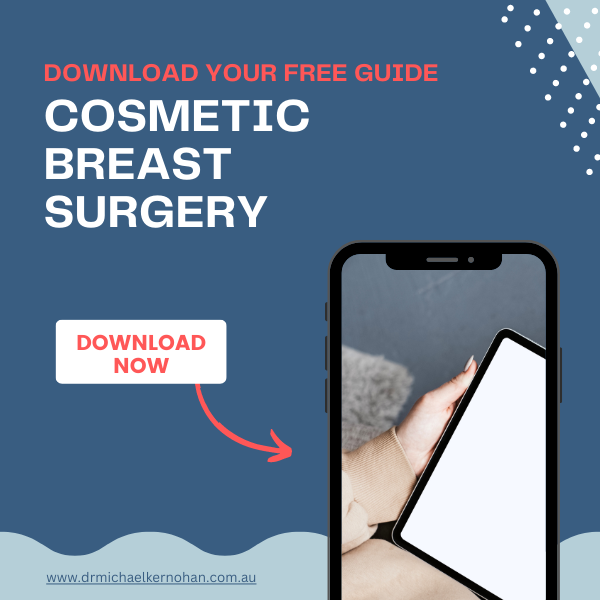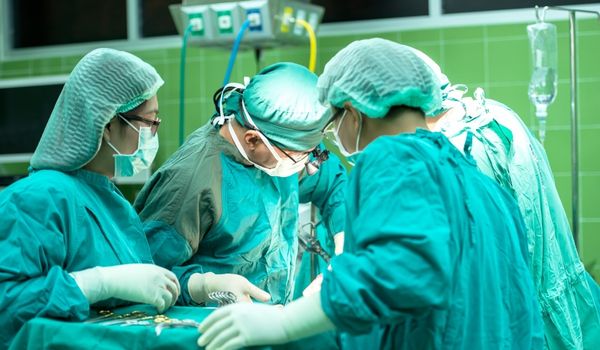Causes and Solutions for Puffy Nipples
Puffy nipples are completely normal and pretty common. Some people love them, while others wish they didn’t have them.
If you notice that your nipples stick out from your breasts more than they probably should, it’s usually because you have a little extra fat or breast tissue behind them. Other reasons for puffy nipples include high estrogen levels and chafing. A simple cosmetic surgery can correct puffy nipples.
Dr Michael Kernohan is a specialist plastic surgeon with years of experience in breast cosmetic surgery. He uses different surgical techniques to enhance the shape of the nipples.
CLICK to Download Dr Michael Kernohan Cosmetic Breast Surgery Guide

What Are Puffy Nipples?
A puffy nipple is when the nipple and the areola (dark-coloured skin) around it form a small, raised mound on top of the breast. The cone-shaped nipple-areola complex protrudes away from the rest of the breast.
Puffy nipples are not uncommon and can occur in men and women, although they’re more common in women. When cold or stimulated, they can harden and become even more pronounced.
Whether you’re a man or a woman, having a puffy and pointy areola is normal and usually isn’t a medical concern.
Anatomy Of The Nipple
The breast is mainly composed of fat (adipose) tissue, milk-producing (glandular) tissue, and connective tissue (Cooper’s ligaments). Your breasts sit on top of a broad, fan-like chest muscle called the pectoralis major muscle.
The nipple-areola complex sits right on top of the breast. Each nipple has a supply of milk ducts and nerves from the breast.
And the areola is the dark-coloured circular area surrounding the nipple. Each areola has oil-secreting (sebaceous) glands that lubricate the nipple to protect it from chafing during breastfeeding.
Your sex hormones, such as estrogen, affect the size, shape, and development of the breasts.
What Causes Puffy Nipples?
Some women, and men, have had puffy nipples for as long as they can remember. Other women only notice them after they become pregnant.
Causes of puffy nipples include:
1. Genetics
Puffy nipples can be hereditary (passed down through your genes).
If you’re genetically predisposed to have pronounced nipples, you’ll start noticing them when you hit puberty or your early teen years.
2. Excess fatty tissue
Some breasts have excess fat tissue immediately behind the nipple-areola complex. This excess fat pushes the nipple and areola forward, creating a cone-shaped or dome-like appearance.
3. Hormonal imbalance
You can develop puffy nipples because of hormonal changes.
For example, certain medications and recreational drugs increase the prolactin hormone blood levels, a hormone that stimulates breast growth and induces milk production. Consequently, the nipple can jut out as a side effect of those drugs, which include some antipsychotic, antiulcer, and cardiovascular medications.
Hormonal changes during puberty or pregnancy can also affect the shape of your nipples.
The estrogen sex hormone is responsible for breast tissue growth and the mammary gland during puberty. Elevated estrogen levels can cause the overgrowth of the mammary gland behind the nipple, causing it to protrude outward.
4. Pregnancy
During pregnancy, the oil glands in the areola become enlarged. That can cause the areola to swell and the nipples to protrude further.
Breastfeeding can also stretch out the nipple and surrounding tissue and cause the nipples to stick out further.
5. Chafing
Jogging and other cardio exercises can cause a lot of friction between your nipples and clothes. That may cause your nipples to swell temporarily and puff out. However, this usually resolves on its own.
How To Get Rid Of Puffy Nipples?
Dr Kernohan will give you a thorough examination to confirm whether your pronounced nipples are genetic or the result of something else.
The solution to your puffy nipples will depend on what’s causing them.
Lifestyle changes to fix puffy nipples
In some cases, estrogen hormone imbalance and excess body fat are responsible for over-projecting nipples. You may be able to fix this by making a few lifestyle changes.

Your surgeon may recommend the following lifestyle changes to lower your estrogen levels:
- A low-fat diet: your fat cells secrete estrogen hormone. Following a low-fat diet can help you decrease your body fat and reduce the amount of estrogen secreted
- Follow a healthy diet: incorporate more fruits and vegetables into your diet and avoid processed sugar. That will help your liver process estrogen and keep its levels in check
- Drink in moderation: limiting your alcohol intake can help your liver break down estrogen and lower its levels
- Avoid stress: stress can throw your hormones out of balance. Find healthy ways to relieve stress, such as yoga, meditation, and exercise, to keep your estrogen and progesterone levels balanced
Alternatively, if your estrogen levels become elevated because of hormone therapy, your healthcare provider might change your therapy plan to restore your body’s hormonal balance.
For some people, plastic surgery is the only way to change how their nipples look.
Dr Michael Kernohan is a specialist plastic surgeon with in-depth knowledge of breast anatomy. He tailors each surgery based on the patient’s unique breast characteristics.
Liposuction for puffy nipples
Liposuction may be enough to get rid of puffy nipples in some cases.
If the patient only has excess fat in the breast that’s pushing the areola and nipple forward, then breast liposuction might be enough to reduce the puffiness of the nipples.
However, liposuction is more suitable for women with elastic skin that can bounce back on the new breast contour after the excess fat is removed.
Plastic surgery for puffy nipples

Some women may have pronounced nipples because of excess breast glandular tissue. In these cases, Dr Kernohan will remove the extra breast tissue through a small incision.
He makes a tiny incision along the lower border of the areola and removes the excess glandular tissue behind the nipple. He might also perform liposuction if excess fatty tissue is also present.
Complications are rare when this procedure is performed. The resulting scar is hidden along the edge of the areola and the differences in colour make it difficult to spot.
Dr Kernohan uses atraumatic and nerve-sparing surgical techniques to help patients retain nipple sensations and the ability to breastfeed after nipple correction surgery.
Nipple reshaping surgery can be done as part of a breast augmentation or reduction surgery to change the shape and contour of the entire breast with the nipples and areola.
FAQs about Puffy Nipples
Can puffy nipples be fixed?
- Absolutely. Puffy nipples can be corrected with plastic surgery. An incision is made under the areola (the circular dark skin around the nipple). The nipples will not be removed. Instead, excess breast tissue behind the nipple is removed with or without liposuction. Nipple correction surgery can improve the appearance of the breasts/chest.
What doctors treat puffy nipples?
- Plastic surgeons can perform a nipple-correction surgical procedure to treat your puffy nipples. Make sure you pick an accredited plastic surgeon with a lot of experience in cosmetic breast surgery. Your plastic surgeon should have in-depth knowledge of the breast anatomy to perform this procedure and give you the best aesthetic outcomes.
Can big nipples be fixed?
- Nipple surgery can help reduce prominent or puffy nipples, reshape a stretched areola, and improve the overall appearance of the nipple-areola complex.
Do men get puffy nipples?
- Yes, men can have puffy nipples (gynecomastia). Men can also get Gynecomastia plastic surgery to correct nipples that puff out. – Read Dr Kernohan’s Blog – What Causes Man Boobs?
Further Reading about Breast Procedures
- Read Dr Kernohan’s Breast Lift Surgery Page
- Read Dr Kernohan’s Breast Augmentation Surgery Page
- Read Dr Kernohan’s Breast Reduction Surgery Page
- Read Dr Kernohan’s Breast Lift with Implants Surgery Page





